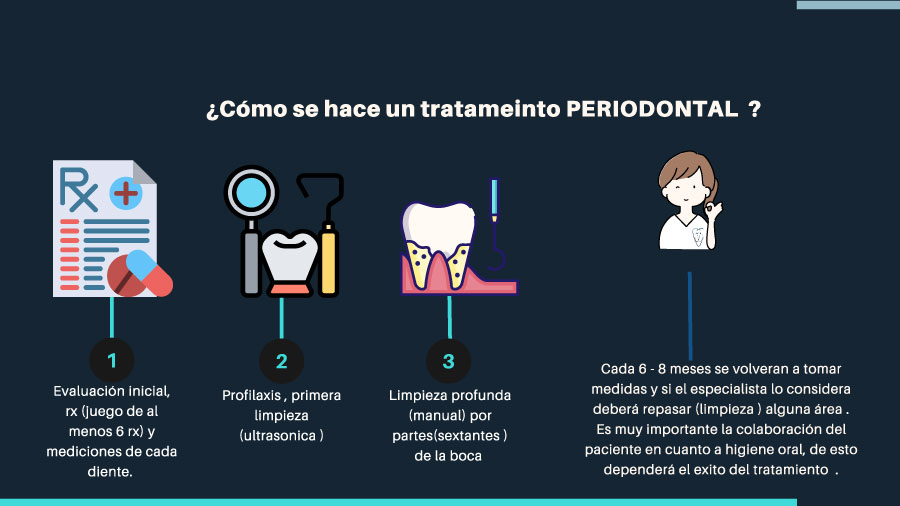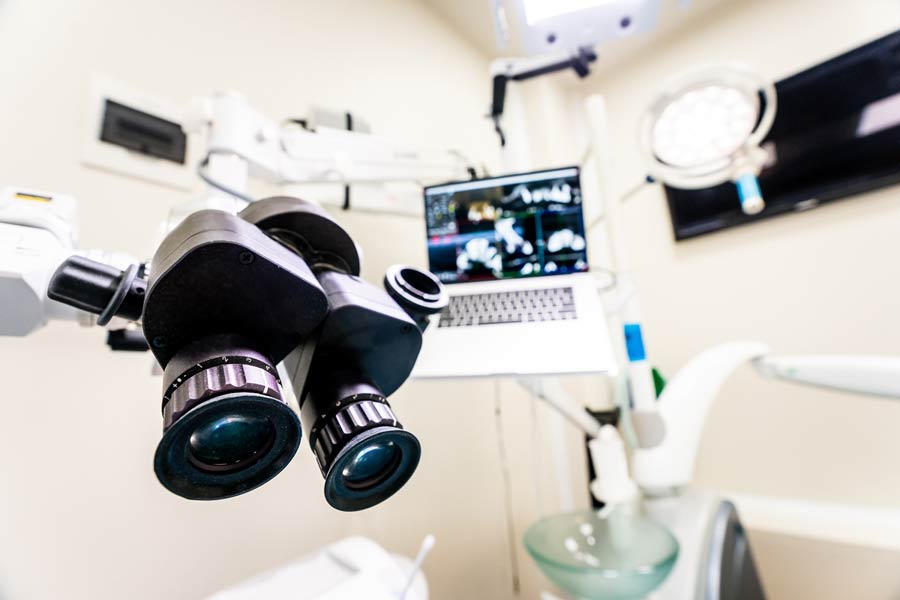

Periodontics
Gum health with advanced techniques and personalized care.
What is Periodontal Treatment or Periodontics?
Periodontal treatment refers to a set of medical and dental procedures aimed at treating periodontal diseases, also known as gum diseases. These diseases affect the tissues that surround and support the teeth, including the gums, alveolar bone, and periodontal ligament.
Periodontal treatment can vary depending on the severity and stage of periodontal disease, but generally aims to stop the progression of the disease, eliminate bacteria and plaque build-up, and restore the health of periodontal tissues. Some of the common procedures used in periodontal treatment include:
- Deep Dental Cleaning: Also known as scaling and root planing, this technique involves removing plaque and calculus (build-ups of bacteria and minerals) from the root surfaces of the teeth. It is performed using manual instruments or ultrasonics to clean periodontal pockets and smooth root surfaces.
- Periodontal Surgery: In more advanced cases of periodontal disease, surgical procedures may be necessary to treat the disease. Some options for periodontal surgery include the removal of inflamed tissue, gingival or bone grafts, and the placement of barrier membranes to stimulate the regeneration of periodontal tissues.
- Antimicrobial Therapy: In some cases, antimicrobial agents, such as mouthwashes or gels, may be used to help control bacterial proliferation and promote the healing of periodontal tissues.
- Periodontal Maintenance: After periodontal treatment, a regular maintenance program including periodic visits to the dentist or periodontist is recommended. During these visits, continuous evaluation of periodontal health, regular cleanings, and monitoring for any signs of disease recurrence will be performed.
Periodontal treatment is essential for stopping the progression of periodontal diseases, preserving the health of the gums and dental support tissues, and preventing tooth loss. It is important to receive a personalized diagnosis and treatment plan from a dental health professional, such as a periodontist, to properly address the individual needs of each patient.
What are the Benefits of Periodontal Treatment?
Periodontal treatment offers a number of significant benefits for oral and overall health:
- Halt of Progression: By addressing gum diseases, periodontal treatment helps to stop the progression of periodontal disease, preserving the health of the gums and dental support tissue.
- Restoration of Oral Health: The main goal is to restore oral health by eliminating bacteria, plaque, and dental calculus, facilitating healing and promoting a healthier oral environment.
- Prevention of Tooth Loss: By stopping the progression of periodontal disease, the treatment helps prevent tooth loss associated with problems in the gums and dental support tissue.
- Comprehensive Evaluation: The initial evaluation of the treatment allows for an accurate diagnosis through examination of the gums, measurement of periodontal pockets, radiographs, and detection of plaque and dental calculus.
- Periodontal Maintenance: The post-treatment maintenance program includes regular visits for professional cleanings and periodic evaluations, ensuring continuous follow-up of periodontal health and preventing recurrences.
With periodontal treatment, the goal is not only to address gum diseases but also to contribute to the overall well-being of the patient, promoting a healthy and lasting smile.

Process
What is the Process of Periodontal Treatment?
Periodontal treatment is a set of procedures aimed at treating and preventing gum diseases and the supporting tissue of the teeth. The main objective is to stop the progression of periodontal disease and restore oral health. Below, I present the common steps in periodontal treatment:

Periodontal Treatment Procedure:
- Initial Evaluation: The first step is to perform a comprehensive evaluation of periodontal health. This includes examining the gums, measuring the depth of periodontal pockets (space between the teeth and gums), radiographs to evaluate the supporting bone, and detection of plaque and dental calculus.
- Deep Cleaning (Scaling and Root Planing): If the presence of bacterial plaque and dental calculus is detected, a deep cleaning is performed. This procedure is known as scaling and root planing. A tool called a curette is used to remove plaque and calculus from the root surfaces of the teeth. The root surface is also smoothed to eliminate bacteria and facilitate healing.
- Treatment of Deep Pockets: If deep periodontal pockets are found, additional treatment may be necessary. This can include periodontal surgery, where the gum is lifted to access the dental roots and remove infected tissue. Antibiotic therapy can also be used to control bacteria.
- Periodontal Maintenance: After the initial treatment, it is essential to follow a periodontal maintenance program. This involves regular visits to the periodontist or dentist for professional cleanings and periodic evaluations of periodontal health. Proper periodontal maintenance is essential to control the disease and prevent its recurrence.
It is important to note that periodontal treatment can vary according to the severity of the disease and the individual needs of each patient. Therefore, it is essential to consult a dental health professional for an accurate diagnosis and a personalized treatment plan.

How often should I undergo periodontal treatment?
Dental curettage, also known as scaling and root planing, is a deep cleaning procedure performed in the treatment of periodontal disease. The frequency at which a dental curettage is recommended can vary depending on the severity of periodontal disease and the individual needs of each patient.
Generally, a dental curettage is recommended when the presence of periodontal pockets (space between the teeth and gums) of 4 millimeters or more, bleeding gums, inflammation, and accumulation of bacterial plaque and dental calculus are detected. Dental curettage is performed to remove plaque and calculus from the root surfaces of the teeth and smooth the root surface to facilitate healing.
After a dental curettage, it is crucial to follow a periodontal maintenance program, which includes regular visits to the periodontist or dentist for professional cleanings and periodic evaluations. The frequency of these maintenance visits can vary, but is generally recommended every 3 to 6 months.
The period of time between dental curettages will depend on the individual patient's response to treatment, the severity of periodontal disease, and the effectiveness of the periodontal maintenance program. The periodontist or dentist will assess the periodontal condition at each visit and determine the appropriate frequency for dental curettages and professional cleanings according to the specific needs of the patient.
It is important to follow the recommendations of the oral health professional and maintain good oral hygiene at home, including regular brushing and flossing, to prevent the buildup of bacterial plaque and maintain long-term periodontal health.
Is it better to undergo periodontal treatment or extract the teeth?
The choice between undergoing periodontal treatment or extracting teeth depends on several factors, including the condition of the teeth, the severity of periodontal disease, overall oral health, the patient's preferences, and the recommendation of the dentist or periodontist.
In general, the main goal of periodontal treatment is to preserve natural teeth whenever possible. Some of the reasons why periodontal treatment is preferred over dental extraction include:
- Conservation of natural teeth: Natural teeth play an important role in masticatory function, aesthetics, and support of facial structures. Periodontal treatment allows keeping natural teeth in place and avoiding the need for dental prostheses or implants.
- Preservation of bone and supporting tissue: Periodontal treatment can help stop the progression of periodontal disease and preserve the bone around the teeth. This is crucial for maintaining the integrity of the dental structure and avoiding bone loss that can occur after dental extraction.
- Improvement of overall oral health: Oral health is closely related to general health. By preserving natural teeth through periodontal treatment, systemic complications associated with tooth loss and dental prostheses can be avoided.
However, there are situations in which dental extraction may be necessary, such as:
- Irreversible damage to supporting tissues: If periodontal disease is very advanced and has caused irreparable damage to the supporting tissues of the teeth, extraction may be the most suitable option.
- Teeth highly affected or with poor prognosis: If a tooth is severely damaged, fractured, or has a severe dental infection that cannot be effectively treated, extraction may be necessary.
- Dental alignment problems: In some cases, tooth extraction may be part of an orthodontic treatment plan to correct malocclusion or dental crowding issues.
It is important to discuss all options with a dentist or periodontist, who can evaluate the condition of your teeth and gums and provide the best recommendation based on your particular situation.
Can advanced periodontitis be cured?
Advanced periodontitis, which is a severe form of periodontal disease, can be controlled and treated, but in some cases, a complete cure is not possible. Periodontitis is a chronic disease where there is progressive inflammation and destruction of the tissues surrounding and supporting the teeth, such as the gums, alveolar bone, and periodontal ligament.
The goal of treating advanced periodontitis is to stop the progression of the disease, control inflammation, promote the healing of damaged tissues, and maintain long-term periodontal health. Periodontal treatment includes different approaches, such as scaling and root planing, dental curettage, periodontal surgery, antibiotic therapy, and regenerative therapy.
In many cases, with proper periodontal treatment and following a long-term periodontal maintenance program, it is possible to control the disease and maintain good periodontal health. This involves a combination of proper oral care at home, regular visits to the periodontist or dentist for professional cleanings and periodic evaluations, and controlling risk factors such as smoking and stress.
However, in advanced cases of periodontitis with severe loss of bone and supporting tissue, it may not be possible to fully recover the lost tissues. In these cases, the goal of treatment is to stabilize the disease and prevent further loss of teeth and bone structures. In some cases, additional treatments, such as the placement of dental implants or dental prostheses, may be necessary to restore oral function and aesthetics.
It is important to note that the success of treating advanced periodontitis depends on various factors, including the severity of the disease, the individual patient's response to treatment, and compliance with oral care instructions and post-treatment maintenance. It is advisable to consult a periodontist or specialized dentist for an accurate assessment of your periodontal condition and receive a personalized treatment plan.
+??%
What is the success rate with the microscrew technique?
The success of periodontal treatment can vary based on several factors, such as the severity of periodontal disease, the individual patient's response to treatment, adherence to oral care instructions, and proper maintenance after treatment. There is no single, absolute success rate that applies to all cases, as each situation is unique.
That said, the main goal of periodontal treatment is to control and stop the progression of periodontal disease, restore gum health, and preserve natural teeth whenever possible. In many cases, periodontal treatment effectively achieves these objectives.
Clinical studies have been conducted to evaluate the effectiveness of periodontal treatment at different stages of periodontal disease. Generally, it has been observed that non-surgical periodontal treatment, including scaling and root planing, can reduce the depth of periodontal pockets, decrease gum inflammation, and improve periodontal health in most cases.
However, it is important to note that periodontal disease is chronic and requires ongoing management to maintain long-term oral health. After periodontal treatment, it is crucial to follow a periodontal maintenance program, which includes regular visits to the dentist or periodontist for professional cleanings and periodic evaluations.
The key to long-term success of periodontal treatment lies in the patient's compliance with home oral care recommendations and regular maintenance. By maintaining good oral hygiene, controlling risk factors, and following oral care instructions provided by the oral health professional, periodontal health can be significantly improved, and the results of the treatment maintained.
It is important to consult a periodontist or dentist for an accurate assessment of your periodontal condition and to receive a personalized treatment plan. The professional will be able to provide more specific information about the prognosis and success of the treatment in your particular case.
What are the benefits of undergoing periodontal treatment at ENIQ?
The use of technology in periodontal treatment can offer several benefits for both the oral health professional and the patient. Here are some benefits of undergoing periodontal treatment with technology:
- Greater accuracy and early diagnosis: Advanced technology, such as digital radiography and cone beam computed tomography (CBCT), allows for more detailed and accurate images of oral and bone tissues. This facilitates an early and precise diagnosis of periodontal disease, helping to initiate treatment in the early stages and improve outcomes.
- More efficient treatment: Modern technologies, such as piezoelectric ultrasound devices and lasers, can facilitate the removal of plaque and dental calculus more efficiently and accurately during deep cleaning. These technologies allow for faster and more comfortable treatment for both the professional and the patient.
- Less invasiveness: Some technologies, like the use of lasers in periodontal treatment, can be less invasive than traditional methods. Lasers can help remove bacteria and infected tissue with greater precision and minimal discomfort to the patient, promoting a quicker and less painful recovery.
- Faster healing: Some technologies, such as growth factors and regenerative membranes, can be used to stimulate and accelerate the healing of damaged periodontal tissues. These technologies promote the regeneration of bone and supporting tissue, which can improve the long-term outcomes of periodontal treatment.
- Better patient experience: The use of technology in periodontal treatment can improve the overall patient experience. Less invasive techniques, faster procedures, and reduced discomfort can make the treatment more tolerable and pleasant for the patient.
It's important to note that not all cases will require the use of advanced technology in periodontal treatment. The choice of technologies used will depend on the severity and complexity of periodontal disease, as well as the availability and expertise of the oral health professional.
It is advisable to consult a periodontist or specialized dentist to get specific information about the technologies used in periodontal treatment and how they can benefit your individual case.
How much does periodontal treatment cost, including curettages, cleanings, and scalings?
- 2024 prices for dental cleaning from major insurance and dental franchises: starting at 57 € for non-insured individuals, otherwise it would be 0€ or deducted from the annual payment. This does not include extras such as plaque detector, bicarbonate, 2nd prophylactic paste, or a surcharge for complex cases.
- 2024 prices for curettage from major insurance and dental franchises: from 39 to 91 € per quadrant, not including extras like laser, loupes, or microscope.
- 2024 prices for surgery from major insurance and dental franchises: from 128 to 220 € per quadrant, not including extras like laser, loupes, or microscope.
Never forget that the best way to save at the dentist is prevention and after treatment attend your check-ups, your cleaning, and annual maintenance.
Follow strict oral hygiene norms such as brushing your teeth 3 times a day, using dental floss at night, as well as using oral irrigators with mouthwashes that contain fluoride and components that prevent plaque and seal the dental structure and defend it from the acidity of food.

- Financing: Up to 24 months without interest. Up to 60 months with preferential conditions.
- Payment installment: Pay for the treatment monthly in comfortable installments.
- Discount for early payment: Paying for the entire treatment at the beginning.
- Multiple payment options: Direct debit, credit card, cash, transfer, Apple Pay, Google Pay, and Bizum.
Periodontics
Oral Health
*Per sextant, subject to specialist assessment
Discover our specialized periodontics service to care for your gum health. We guarantee effective and professional treatments.
-
All-inclusive
-
Interest-free financing
Frequently Asked Questions
Do you have more questions about dental periodontics treatment?
Yes, it's an old term that was used to name periodontal disease.
Periodontal treatment, including procedures like scaling and root planing, dental curettage, or periodontal surgery, is performed with local anesthesia to minimize any discomfort or pain during the procedure. Most patients experience only mild discomfort or pressure during the treatment, but not intense pain.
During periodontal treatment, the oral health professional will administer local anesthesia to numb the treatment area. This ensures that the patient is comfortable and pain-free during the procedure. However, you may feel some sensations of pressure or vibration as the professional works on the tissues and dental roots.
After periodontal treatment, you may experience some sensitivity or discomfort in the gums and teeth. This is normal and usually subsides within a few days. The oral health professional may recommend over-the-counter pain relievers to alleviate any postoperative discomfort.
It is important to note that the experience of pain or discomfort during periodontal treatment can vary depending on individual sensitivity, the severity of periodontal disease, and the type of procedure performed. If you have any concerns about pain or discomfort during periodontal treatment, it is advisable to discuss it with your periodontist or dentist. They will be able to explain the procedure in detail, provide you with pain management options, and answer all your questions so that you feel more comfortable and confident during the treatment.
Yes, periodontal disease has been linked to general health problems, such as heart diseases and diabetes. Therefore, it is advised to treat and even prevent it as soon as possible.
